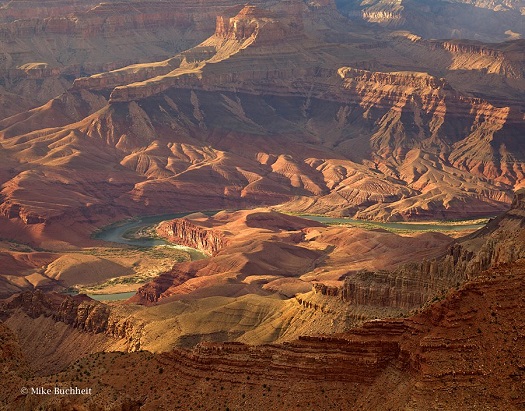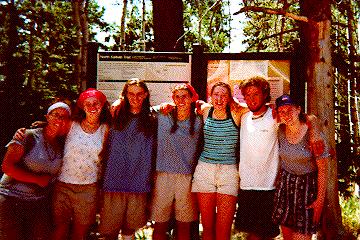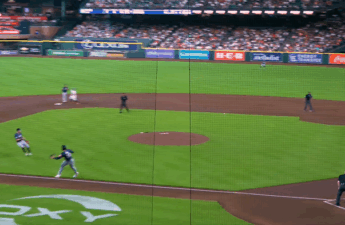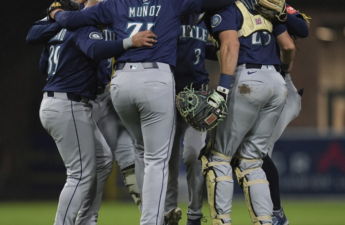
When I was in college, one of my closest college friends, Stina, spent the summer of 2000 working at a cafeteria in the Grand Canyon. It’s one of those quirky little facts of American life that you might not think about that college students from all over the country (and beyond!) migrate to the National Parks each summer for low paying service jobs in beautiful settings. Attendance at the NPs explodes over the summer and the cafeterias, restaurants, and lodges need all the help they can get keeping up. And the big perk is getting to live and play in the midst of what have been designated as the country’s best natural wonders.
The living part was a big fascination for me when she first announced this plan, since I’d long grown up with the notion that no one was allowed to live in National Parks. It’s one of those slight oversimplifications of childhood that really sticks in one’s mind – there were a few particular facts my parents told me in very early childhood that had a powerful impact on my thought processes. I remember that they explained the Soviet Union to me by saying that the government didn’t allow people to move if they wanted to. It’s funny that our family was so itinerant that this struck me as a draconian regulation, the disallowance of someone moving across the country. They did say move both within the country and to leave it, and this was most of what they said about the USSR. That and to point out that Communists were not nearly the “enemy” that Reagan made them out to be.
I think the National Park living fact, like this other fact about where you can move, stuck in my head because I so desperately wanted to move to a National Park after first visiting one. The first was probably Sequoia National Park, or King’s Canyon (the two share a long border and function as the same park, even more than the proximate Yellowstone and Grand Tetons), when I was a young child in nearby Visalia, California. Indeed, I may have even forgotten that I somehow prompted the fact of not being able to live in a National Park by asking my parents point-blank if we could move there. Thus began a childhood obsession with hiking and camping, the latter of which became a bit of a white whale for my upbringing – my parents were just not into camping. But we did go hiking a bunch, and in a National Park whenever possible.
You can imagine my fixation, though, when Stina told me she was going to live in a National Park, if only for a couple months and only in a dorm that made Brandeisian accommodations look spacious (that was the rumor; the dorms in the Grand Canyon turned out to be much nicer than ‘Deis). I think I argued with her that this wasn’t possible and she would have to live just outside of it and it wasn’t until she pointed out that her parents had done the same thing with one of their summers that I deferred to her understanding of the situation and realized that information gleaned when I was five years old may have been slightly oversimplified. Given that I was spending the summer in Albuquerque and (as it turned out) without a consistent summer job, the opportunity to visit and stay in the Grand Canyon for periodic stretches opened up before me.
The Grand Canyon is a roughly 8-hour drive from Albuquerque – or exactly the kind of distance that feels like a reasonable jaunt to a Westerner and something you might as well fly for instead to an Easterner (by and large – I know there are exceptions to these regional archetypes). The first time I went to visit, I did have perhaps my closest near-death experience in a vehicle, wherein I fell asleep in hour 6 (not dozed, but just full-on lost consciousness) and startled awake 30-60 seconds later squarely placed in the opposite fast lane. I think someone’s honking woke me up. I have rarely been so terrified, but I immediately realized that I couldn’t just swerve back into the neighboring lane and I actually put on my turn signal and checked my blindspot before crossing back over the double-yellow to return to the appropriate fast lane for my direction of travel. But then I was there, harrowed a bit, but present in one of the most glorious landmarks known to Earth, and then in its possibly most run-down cafeteria, where Stina was dishing out portions of standard-issue food to fascinated tourists from all over the globe.
I took either two or three trips out there that season, but the big one was to join Stina and several of her co-worker friends on a trip through the heart of the Canyon and back again, going Rim to Rim to Rim. If you haven’t spent a lot of time in the Grand Canyon, and especially if you’ve never been, you may not realize the exact size and scope of the place. It’s 271 miles long, end to end, and 18 miles wide in some places. There’s roughly a mile of elevation difference between the top of the Canyon and the bottom; 1,000 feet more if you’re counting from the North Rim. The South Rim and North Rim are so disparate as to have almost entirely separate climates. The South is high desert; the North feels almost Alpine, covered with evergreens and, in winter, a thick blanket of snow. The bottom of the Canyon is a convection oven, especially in summer, relieved only by the refreshing ribbon of the Colorado river that snakes through the chasm and continues to shape it after millions of years of work.
I could write about the Canyon forever, as I could probably describe the play-by-play of that trip forever. Going Rim to Rim to Rim entails starting at the top of the South Rim, hiking into the Canyon and all the way to the bottom, riverside, then crossing the river and starting up the side of the North Rim, hitting the top of that, and then making the return journey. It’s even crazier than it sounds. The total mileage covered is about 50 overland, but you’re also covering four miles of elevation change and almost none of the journey is flat land. I think all seven of us who made this particular trip together had serious misgivings about our own physical fitness for such an adventure. My knee started having problems on the second day and I made the rest of the journey with a jerry-rigged ace bandage, often described by the rest of the party as looking like a wounded veteran. I had opted out of the communal food plan the other six were sharing, partially because I’m a vegetarian but mostly because I’m me and don’t like most food. I had unwisely opted to bring a block of cheese in my backpack, among other edibles, which had the seriously nasty habit of melting during the day and reforming at night, giving it that leftover-quesadilla consistency at all times. It was, after all, late July, probably the hottest time of the year.
Did I not mention the weather yet? It was 120 degrees in the base of the Canyon. You couldn’t really hike during the day at all and we scheduled most all the hiking for overnight or the first few hours of daylight before the sun got too hot. The trip started at the literal crack of dawn, not counting the 45-minute pre-dawn bus ride to the jumping-off point. The only time in my life I’ve ever been too hot to sleep was during that fist day in the base of the Canyon, hanging around Phantom Ranch when it was about 121 out, and half of us decided to go nap half-submerged in a nearby creek. Our only real daytime hiking was the last leg, trekking back up the South Rim, when we were too exhausted and done with the trip to care and would stop at every mile-house on the way up to remove our shirts, soak them in water, and throw them back on wet. They’d evaporate to bone dry in about 10 minutes.
You can read my first-hand accounting of the trip here, but it doesn’t really do it justice. I was four months into blogging and the lens I used for everything was my tumultuous emotional state (I know, what’s changed, right?). Though the mood swings then were perhaps slightly more justified by the incredible power of the journey. The camaraderie and brief conflicts of sharing a Hobbit-like adventure across a gorgeous landscape, the way the Canyon changes every five minutes and every twenty feet, offering a new perspective from every angle and depth and time of day. The stress of putting one’s body through its hardest paces, not really knowing if you will have to be airlifted out of there on an embarrassing helicopter because you bit off more than you could chew. The scorpions. I got over my fear of scorpions there, because you had to, because they were all over, especially at night, and sometimes you just had to go to sleep on the trail, with a 500 foot drop on one side and scorps on the other and you just couldn’t care anymore.
In the full light of memory, this trip has become legendary. But I kind of think it was legendary in a lot of ways. I have consistently described it as the hardest physical thing I have ever done, and one of the greatest accomplishments of my life, and I stand by those statements. As a general rule, I don’t put a lot of stock in the physical or the athletic, baseball fandom aside, but this was a place where my body and I really converged on the same goals. I was in the best shape of my life for that trip. It was breathtaking and amazing and unforgettable.
I want to do it again.
No, I’m serious.
I heard on the radio yesterday that it was the 96th anniversary of Grand Canyon National Park. Set aside only in 1919 for preservation (I guess it was a National Monument 11 years prior), GCNP is looking forward to its 100th birthday in four short years. And the year after that, it’ll be the 20th anniversary of my own Rim to Rim to Rim journey.
Sometime in that window, between February 26, 2019 and July 2020, I want to go back and do the trip over. I am throwing down. I want to be someone who is capable of doing that at 40 and does it and lives to tell the tale.
You can keep your marathons and your running for running’s sake. Those are great. Whatever goal you want to set for yourself is awesome. I just want my fitness goal to be in the most beautiful place yet discovered by human beings.
This goal is about a lot of things for me. It’s about acceptance of being someone who is going to be around for a while (more on this in another post). It’s about the holy stature of the Grand Canyon in my world. It’s about being 160 pounds at age 35, up 33% from where I was at age 30 (though, granted, 120 was unhealthy too for all kinds of reasons at the time). It’s about needing a specific, measurable goal for efforts to combat aging and weight-gain and all the things that hit Americans in their 30s.
And it’s about recruiting. I want you to join me. I’m setting this goal way way way in the future so we can plan together, if you’re interested. So we can get the vacation time and you can train too and we can all go together when we go. For most of you who might consider this, it’ll be the first time and I promise it will be one of the best things you’ll ever do. But I’m more than open to a reunion tour with anyone who went with me the first time, or anyone who went on their own.
Who’s with me?!



